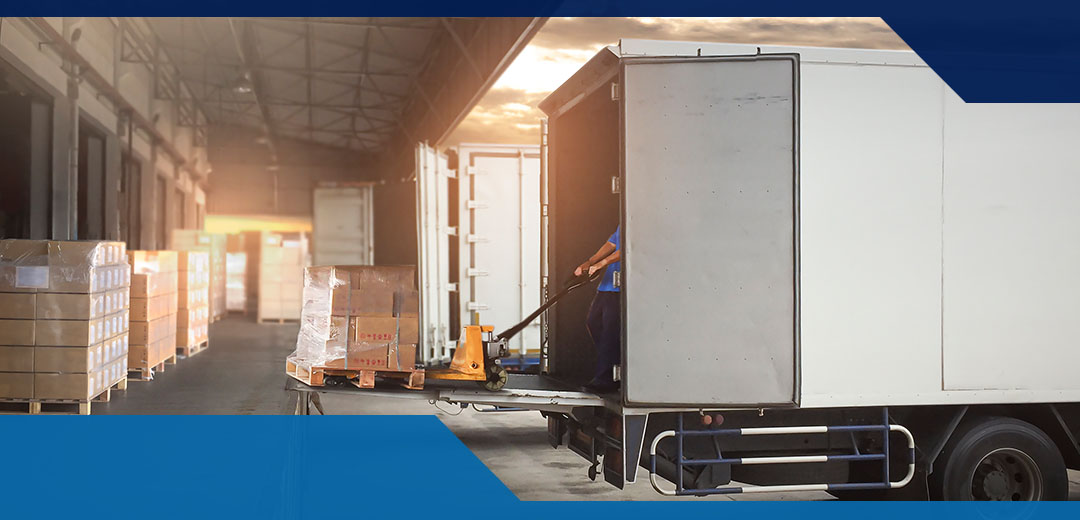
Logistics is the backbone of efficient supply chain management. It encompasses the planning, execution, control, movement and storage of your products. Looking into the various logistics models is critical as your business strives for streamlined operations and improved customer service. From first-party to seventh-party logistics, each solution can help you navigate the complexities of your supply chain and improve your bottom line.
Read on to learn about the unique characteristics of each logistics model, including examples and applications where they work best. Explore the differences between each model and how to choose the best one to leverage for your business’s success.
What Are Party Logistics?
Party logistics (PL) involves outsourcing logistics functions to third-party service providers. The framework lets businesses focus on their core functions while leveraging the expertise and resources of logistics specialists. The term “party” refers to the number of entities involved in the logistics, ranging from the original manufacturers to intermediaries and end consumers.
Each logistics model denotes a different level of service, complexity and integration in the logistics process. The evolution from 1PL to 7PL shows the sophisticated logistics solutions now available to businesses.
What Is 1PL?
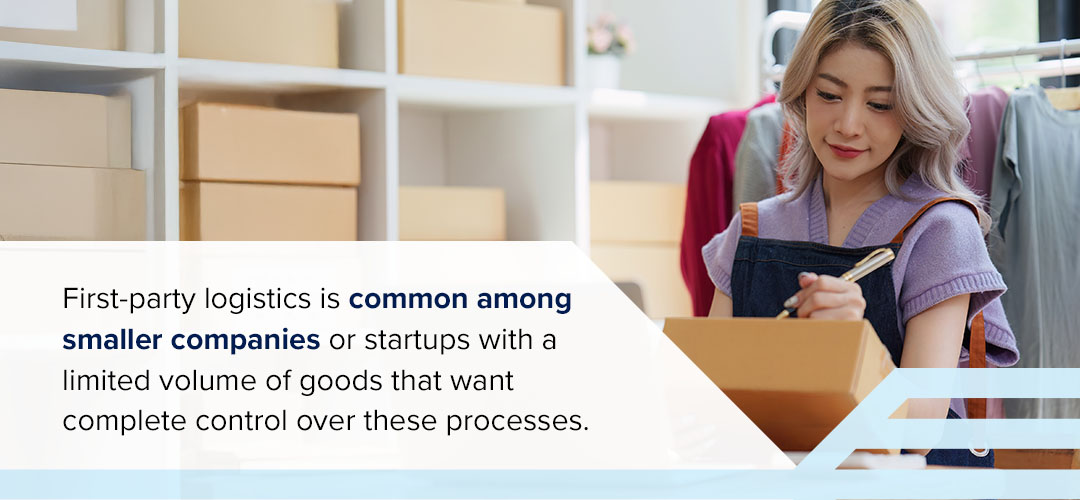
1PL is the most basic form of logistics, where a company manages its own transportation and logistics operations. In this model, your business is responsible for all logistics activities, from warehousing and inventory management to handling shipments and customer interaction. First-party logistics is common among smaller companies or startups with a limited volume of goods that want complete control over these processes.
Nowadays, fewer companies handle their own logistics, as outsourcing helps them stay quick and flexible.
1PL Examples
Examples of 1PL include:
- A local farmer transports produce directly to a market
- A local artist sells handmade crafts at local fairs, handling transport and booth setup on their own
- A boutique coffee roaster manages its own deliveries to local cafes and retail outlets
- A small clothing brand ships orders directly to customers using in-house logistics
- A family-owned bakery delivers freshly baked goods to nearby stores and farmers’ markets
In these cases, businesses manage every aspect of their logistics, from handling their fleet to organizing storage facilities.
What Is 2PL?
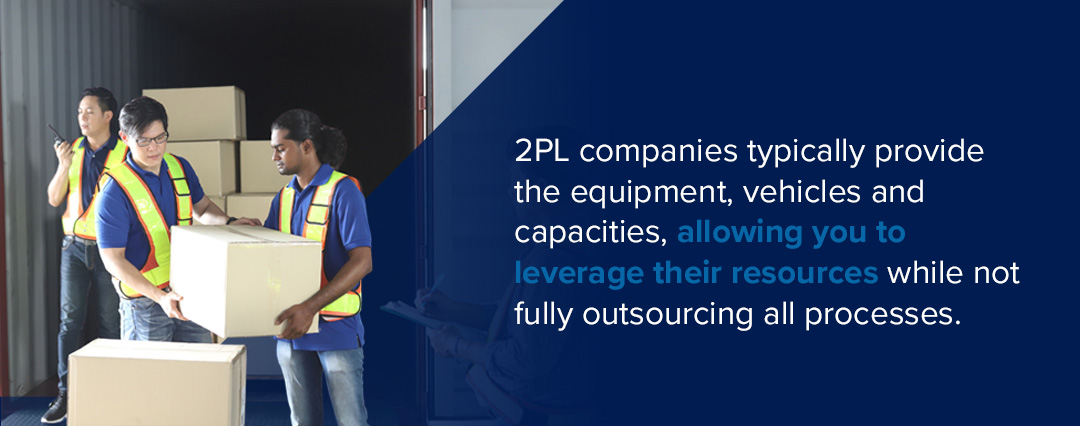
Second-party logistics services include only transportation within the supply chain. Under this model, you manage warehousing and inventory while using external carriers to move goods — whether by road, rail, water or air. 2PL companies typically provide the equipment, vehicles and capacities, allowing you to leverage their resources while not fully outsourcing all processes. This arrangement can increase efficiency, helping you reduce costs and respond flexibly to market demands.
2PL Examples
An example of 2PL is a manufacturer that contracts a trucking company to transport its products from the factory to a distribution center while handling storage and inventory management themselves. Another example could be an e-commerce company partnering with a courier service for last-mile delivery while managing its own warehousing operations.
What Is 3PL?
When a company’s logistics requirements become too complex to handle internally, third-party logistics partners offer more integrated services. These include transportation, warehousing, inventory management and order fulfillment. These services let you focus more on your core operations while relying on 3PL partners to optimize your supply chain.
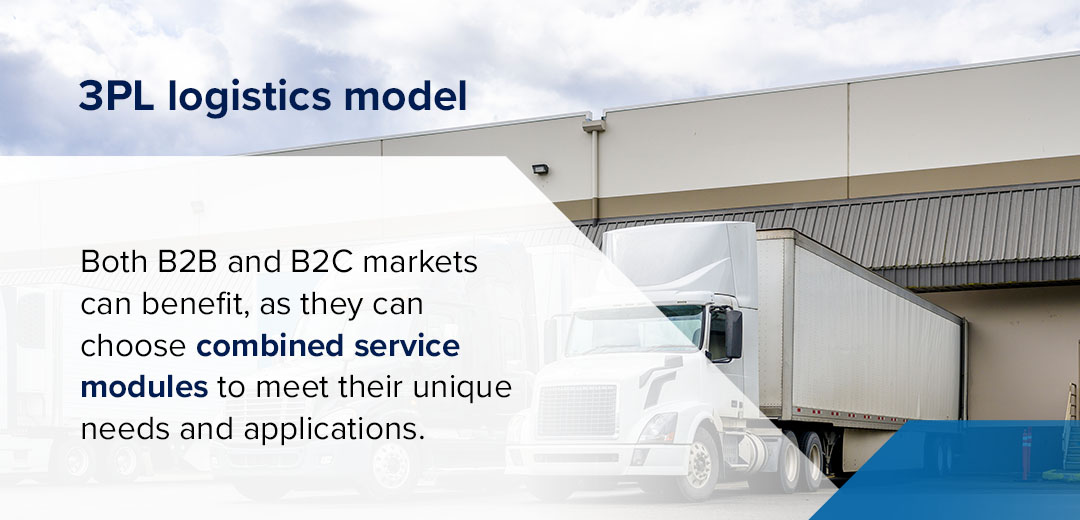
3PL service providers typically rely on advanced technologies and digitized solutions. For example, RFID-based systems can automate warehouse procurement, while digital and paperless solutions typically guide transport. Within the 3PL logistics model, both B2B and B2C markets can benefit, as they can choose combined service modules to meet their unique needs and applications.
Given their adaptability and range of services, 3PL logistics models can meet the needs of larger companies and achieve their unique goals through a single provider.
3PL Examples
An example would be an e-commerce retailer partnering with a 3PL provider to handle order fulfillment, inventory management and shipping logistics. That way, the retailer could focus on scaling operations without investing heavily in infrastructure.
Sector-specific logistics systems can also be implemented for clients, such as those in the chemical and pharmaceuticals or temperature-controlled transport sectors like the food sector.
What Is 4PL?
Fourth-party logistics providers act as consultants, managing the entire logistics process on your company’s behalf. While they do not have the physical assets to move products, 4PLs might contract with freight companies, 3PLs and other service providers, assembling organizations’ resources, capabilities and technologies to enhance efficiency.
When you opt for this unique supply chain solution, providers will design and implement unique logistics models for your needs. They’ll use advanced technologies and gather deep insights into your business model to promote a more effective supply chain. These services can generate long-term benefits and clear added value for your business, prioritizing operational optimization, transparency, reduced costs and sustainability.
4PL Examples
Medium-to-large businesses typically leverage 4PL services. Fourth-party logistics providers offer end-to-end supply chain management and consulting — allowing companies to focus on their products instead of the complexities of their supply chain.
What Is 5PL?
Fifth-party logistics combines the services and shipping needs of multiple 3PLs and 4PLs, allowing them to negotiate better carrier rates and create a seamless supply chain experience. 5PL represents an evolution in logistics services, focusing on managing supply chain networks for businesses with complex logistics needs.
When you choose 5PL, you will benefit from integrated technology, data analytics and optimized operations across various channels and platforms. These solutions can help your company adapt to rapidly changing needs, as they bundle expertise in digitization, supply chain, big data analytics, the Internet of Things (IoT) and automation. This model aims to create autonomous, self-optimizing and efficient supply chains.
5PL Examples
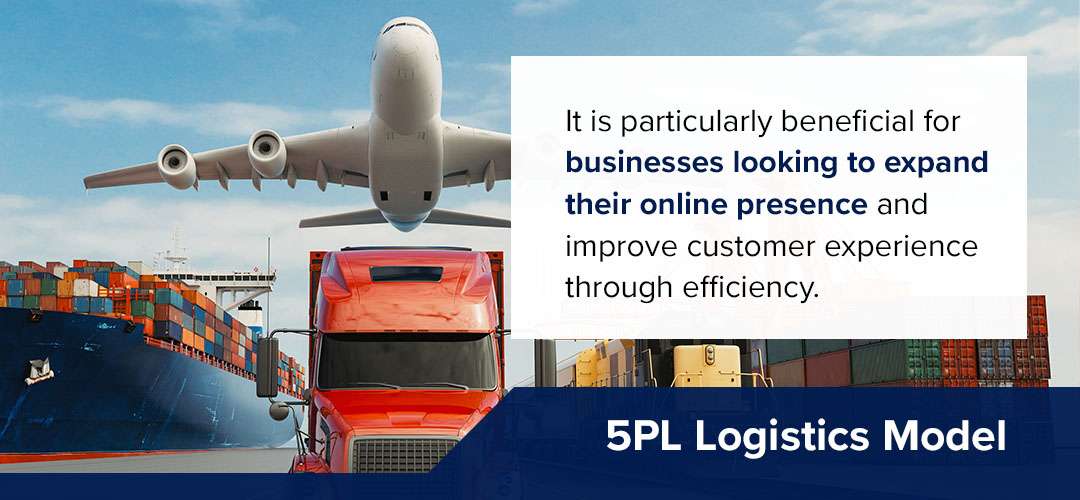
An example of 5PL is a logistics company that manages e-commerce fulfillment for multiple online retailers. It integrates various shipping and warehousing solutions, which is particularly beneficial for businesses looking to expand their online presence and improve customer experience through efficiency.
What Is 6PL?
With technological advancements and artificial intelligence (AI) entering the supply chain, outsourced logistics services have risen to new levels. That’s where sixth-party logistics services come in. While not fully realized, 6PL will soon encompass a supply chain seamlessly integrated and semi-automated with AI and machine learning tools. 6PL services can span the entire supply chain, leveraging trends, ordering patterns and predictive models to optimize logistics operations. This model could initiate production, provide delivery instructions and identify discrepancies in an instant.
6PL Examples
Advancements in autonomous vehicles, delivery drones and warehouse robots are already contributing to the emerging concept of 6PL. B Corporations, which must meet high social and environmental standards, will find these services highly valuable. These 6PL providers will manage transportation and warehousing for manufacturing while collaborating on product development and inventory planning. The integrated approach lets businesses streamline operations and improve efficiency.
What Is 7PL?
Seventh-party logistics combines 3PL and 4PL services to provide full-service fulfillment, warehousing and transport services under one umbrella. The 7PL provider offers a big-picture approach to 4PL management while adding the ownership and control of physical assets typical of 3PLs. This creates a one-stop shop for fulfillment and supply chain management, with services like:
- Warehousing
- Inventory management
- Customs clearance
- Transport services
- Consultation services
- Project management
- Sourcing and negotiation
- Logistics strategy and analytics
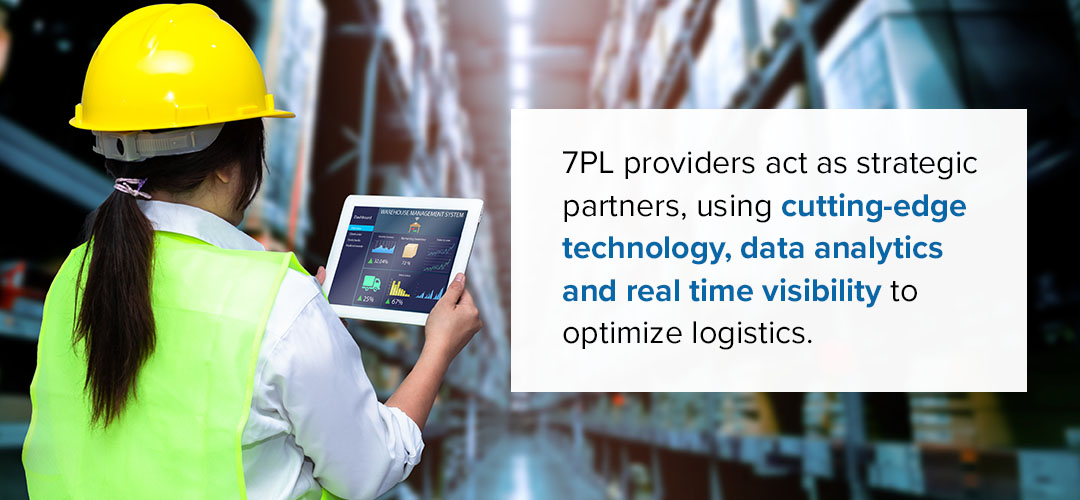
7PL providers act as strategic partners, using cutting-edge technology, data analytics and real time visibility to optimize logistics. They work closely with businesses to develop innovative solutions, helping drive efficiency and improve customer experience.
7PL Examples
An example of a 7PL is a logistics firm that collaborates with a multinational corporation to design and implement supply chain strategies such as logistics, inventory management and demand forecasting. This partnership allows the corporation to focus on its core business while leveraging the expertise of the 7PL provider to optimize its logistics operations.
Why Are There Different Logistics Models?
Different logistics models exist to address the varying needs of businesses, their industries, product types, market reach and demand fluctuations. As your company grows, you will likely require more intricate solutions and a tailored approach. Outsourcing your logistics processes can help you effectively manage the flow of goods, optimize costs and ensure timely delivery.
Each logistics model helps businesses adapt to different market dynamics. The levels let them choose the services as needed, with key features including:
- Scalability: Some models are designed for flexibility, where your business can easily scale up or down based on demand changes. Others are more fixed and less adaptable.
- Cost efficiency: Each model has its own cost structure, with some prioritizing low-cost transportation and others focusing on high-value services.
- Control level: Different models provide varying degrees of control over logistics, so you can choose how much you want to manage on your own vs. outsourcing.
Ultimately, multiple logistics models enable businesses to choose the right level of service that aligns with their operational goals, budget and growth trajectory.
Logistics Models Comparisons
Logistics models differ in terms of services provided, control and complexity. The following is a comparison of each model, focusing on their unique characteristics and differences:
1PL vs. 2PL
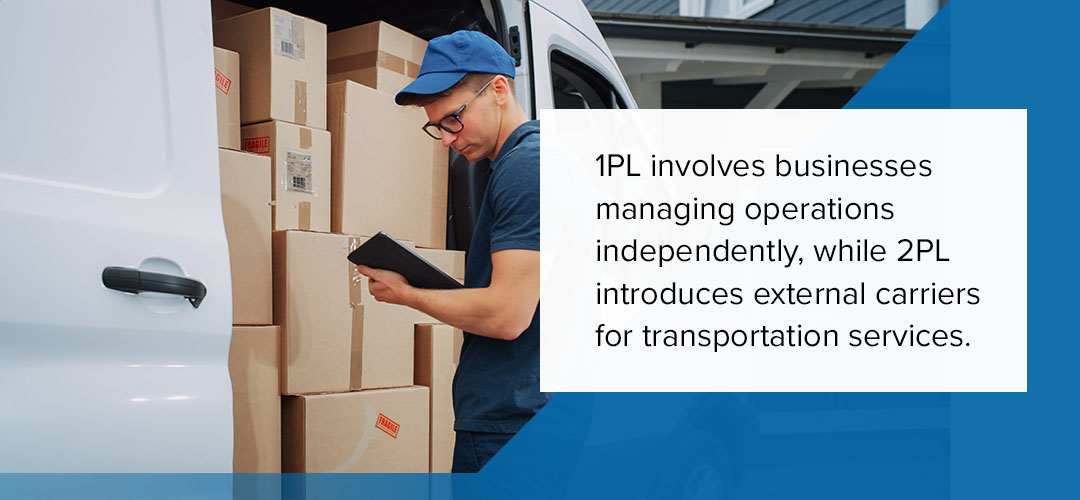
1PL and 2PL represent the first stages of logistics outsourcing. 1PL involves businesses managing operations independently, while 2PL introduces external carriers for transportation services. Their key differences lie in the level of outsourcing and control. Companies might use 1PL to retain complete control over their logistics, making it suitable for smaller businesses. In contrast, 2PL allows companies to benefit from transportation services, enhancing their efficiency without giving up complete control.
2PL vs. 3PL
The transition from 2PL to 3PL marks a massive shift in logistics strategies. While 2PL providers focus primarily on transportation, 3PL offers a broader range of services, from warehousing and inventory management to order fulfillment. This expansion further allows companies to streamline their logistics processes, achieving greater efficiency and performance. For this reason, businesses that require a more comprehensive logistics approach typically opt for 3PL for its full spectrum of services.
3PL vs. 4PL
The difference between 3PL and 4PL lies in ownership and control. While 3PL companies generally own and operate their warehouses and transportation, 4PL companies focus more on the higher-level coordination of the supply chain. A 3PL will manage day-to-day operations, while a 4PL optimizes the entire supply chain, including third-party assets.
Although both models involve outsourcing logistics, 4PL providers take a more strategic approach and oversee the entire process. This strategic oversight allows businesses to focus on their core operations. Companies seeking a higher level of integration and strategic partnership usually choose 4PL over 3PL.
4PL vs. 5PL
4PL and 5PL services differ in terms of their complexity and scope. 4PL providers focus on logistics management and coordinating multiple providers. In contrast, 5PLs integrate technology and data analytics to optimize the overall network of logistics teams. 5PL benefits businesses with complex logistics needs, such as e-commerce companies. These providers use digital solutions and cross-channel logistics integration to oversee the operation.
5PL vs. 6PL
As logistics models evolve, the transition from 5PL to 6PL brings even more integration to supply chain management. While 5PL providers focus on logistics network management and e-commerce solutions, 6PL providers provide more comprehensive services, including logistics, procurement, production, and distribution. This holistic approach allows businesses to streamline operations and achieve greater efficiency through collaborative partnerships.
6PL vs. 7PL
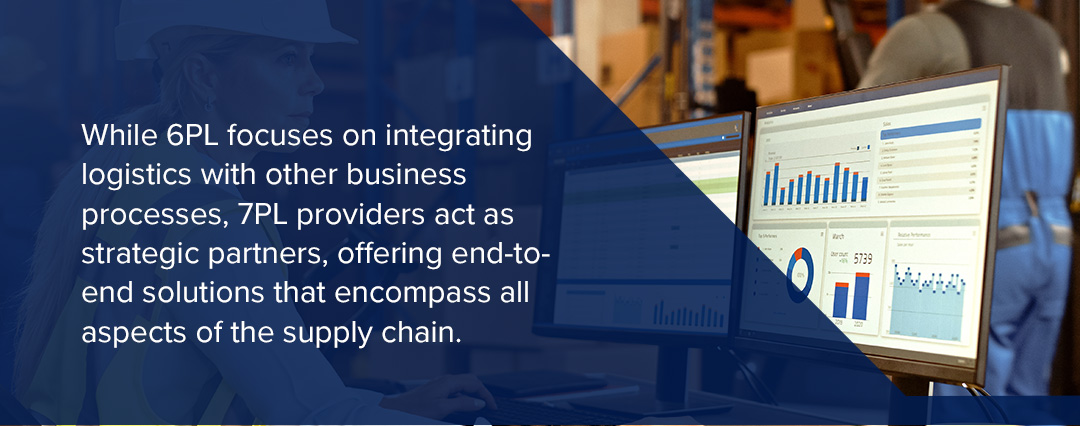
6PL and 7PL represent the pinnacle of logistics service integration. While 6PL focuses on integrating logistics with other business processes, 7PL providers act as strategic partners, offering end-to-end solutions that encompass all aspects of the supply chain. The key distinction lies in strategic collaboration and the use of advanced technologies. 7PL providers leverage data analytics and real time visibility to optimize logistics operations, making them ideal for businesses looking to drive innovation and enhance the customer experience.
How to Choose the Right Logistics Model
Your logistics model will depend on where you want to spend most of your time. Some business owners feel more comfortable when involved in the supply chain decision-making process. Others want to outsource as many logistic tasks as possible, giving them more time to focus on other aspects of running the business. Many business owners fall somewhere in the middle. They want their operations to run smoothly but don’t have the time to monitor all aspects of the supply chain.
Choosing the right model is critical in optimizing logistics and achieving business goals. The following steps can help guide you toward the right decision:
1. Assess Your Business Needs
Start by evaluating the scale of your operations. Consider the complexity of your supply chain and your logistics requirements. Think about your order volume, product types, distribution channels and delivery timelines. It also helps to understand your customer base and their expectations. For instance, if you operate in a market that demands rapid delivery, your chosen logistics model must support that urgency.
2. Determine Your Control Preferences
Decide how much control you want over your logistics operations. If retaining full control is essential to your business strategy, 1PL or 2PL might be suitable, as you can manage logistics on your own or with a limited external partnership. If you want to outsource more functions, consider 3PL or higher-level models. Weigh the benefits of control against the time and effort needed to manage your logistics effectively. Your choice should balance your comfort level with oversight and your desire for efficiency and convenience.
3. Evaluate Budget Constraints
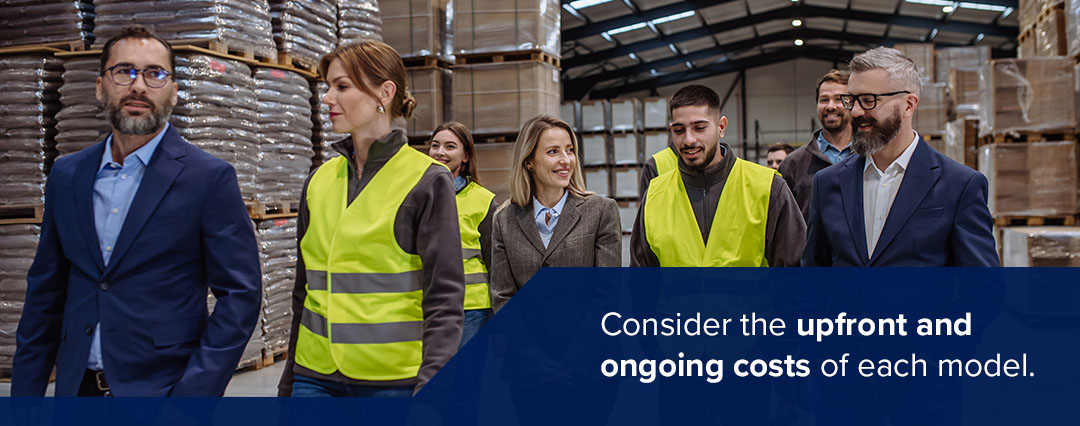
Analyze your budget and determine how much you can invest in logistics services. Each model comes with different costs, so make sure your chosen service aligns with your financial capabilities. Consider the upfront and ongoing costs of each model. For instance, 1PL and 2PL may seem affordable initially, but managing logistics internally can require more investments in resources like equipment, technology and personnel.
In contrast, although 3PL or higher-level models may require higher upfront costs, they tend to lead to long-term savings through economies of scale, optimized processes and less administrative burden. Consider the potential return on investment and customized solutions offered by logistics providers so you can tailor your strategy to your budget.
4. Research Providers
You need a trusted partner who will provide the right services for your unique business. When searching for a logistics provider, check that they have expertise in your industry and a track record of delivering reliable services. The best logistics providers will provide custom services, so if you need something specific, they will work with you every step of the way to see it successfully move through the supply chain. This includes specialized handling of parts and accessories.
Additionally, you should choose a service company with various capabilities and technologies, from automation to track and trace solutions. For instance, EMO Trans provides technology that offers real time visibility over your shipments so you can manage the entire journey from booking to proof of delivery.
5. Consider Future Growth
Choose a logistics model that can scale with your business. As your operations expand, ensure that the chosen model can accommodate increased demand and complexity. If you think you’ll be entering new markets or launching new product lines, be sure that your logistics provider can adapt to these changes without disruption. Look for flexible solutions like adjustable transport capacities or expandable warehousing options.
6. Seek Expert Consultation
If you need help choosing a model, consult logistics experts or service providers who can offer insights and recommendations for your specific needs. Industry professionals can help you navigate logistics options and identify potential pitfalls. They can thoroughly assess your operations and future growth while introducing you to best practices and trends so you stay competitive in your market. 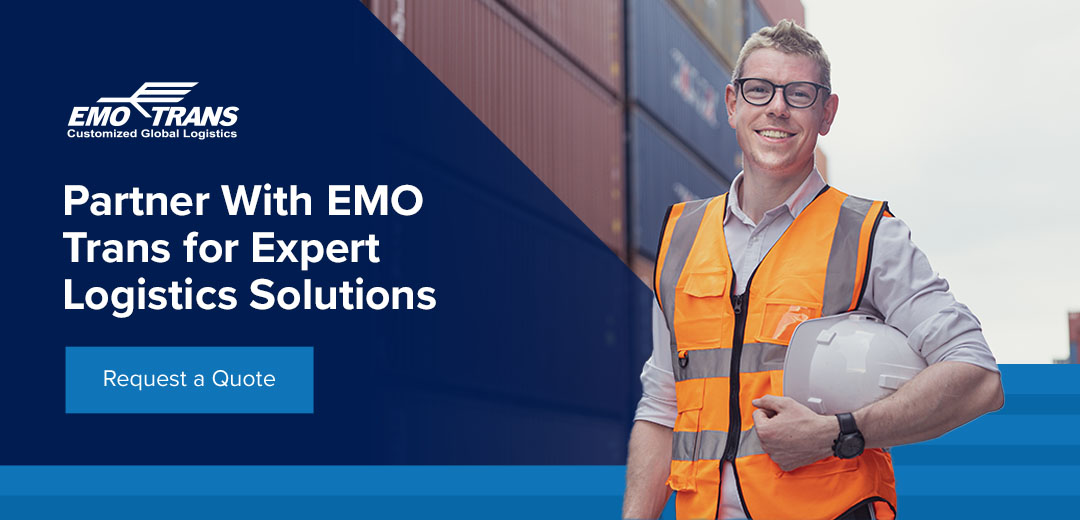
Partner With EMO Trans for Expert Logistics Solutions
Navigating the world of logistics can be complex, but understanding the various models will help you make informed supply chain decisions. With each model offering unique benefits and tailored services, you’re sure to find a solution for your specific needs. As a leader in the logistics sector, EMO Trans is well-equipped to guide you through your logistics journey. With extensive knowledge and experience, we can ensure a customized approach to your logistics processes.
For over 50 years, we have provided personalized solutions for our clients. Our extended network lets us collaborate on a global scale, providing the coverage and flexibility you need and expedited services when required. Whether you’re a small business looking for basic transportation services or a multinational corporation seeking comprehensive logistics management, our experts have the knowledge and resources to support your logistics goals.
If you’re ready to enhance your logistics operations and explore the best solutions for your business, request a quote today. We can be your partner in driving logistics efficiency and success.
